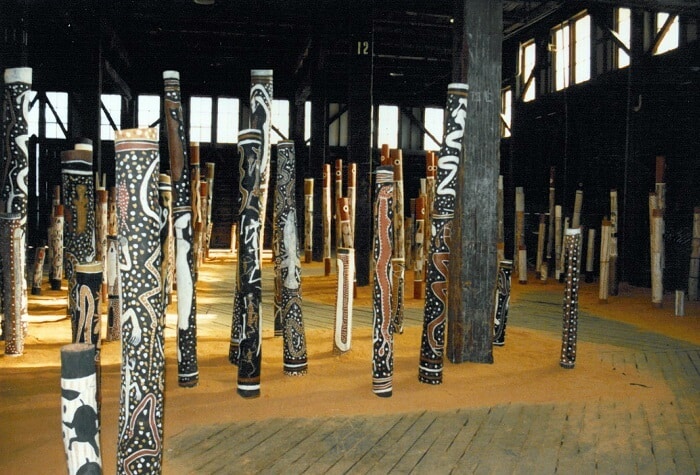Standing in the main entrance hall of the National Gallery of Australia (NGA) is The Aboriginal Memorial (1987-88), a powerful installation work comprised of 200 hollow burial poles dedicated to the memory of all Aboriginal people who have died protecting their land since the beginning of European settlement in Australia in 1788.

Djon Mundine OAM is a member of the Bundjalung people of northern New South Wales and is an artist, independent curator, activist and writer. Through numerous curatorial positions in major national and international art institutions Mundine is recognised as one of the key figures who has played a pivotal role in activating change for the way Aboriginal art is viewed and exhibited.
Mundine conceived the idea for The Aboriginal Memorial while working as an art advisor at Milingimbi in the Crocodile Islands and at Bula-bula Arts in Ramingining in the late 1980s. More than three decades after the inauguration of the work, in the third presentation of ACCA’s ‘Defining Moments’ lecture series, which looks back on some of the exhibitions that have been central to the changing landscape of art in Australia between 1968 and 1999, Mundine reflects on the stories and people that were involved in the development of the Memorial project, the significance of the work and the vital importance of its ongoing presence for truth telling and justice for Aboriginal peoples past and present in Australia.
In collaboration with Mundine, The Aboriginal Memorial was created by 43 artists who came together from across five groups from the Ramingining communities of Central and Eastern Arnhem Land, and who drew inspiration from the traditions of the hollow log or bone coffin ceremonial burial practices that are unique to the people of Arnhem Land. In his lecture Mundine shares his knowledge and understanding of the intimacies and processes of these practices and how they are central to the message of this momentous Aboriginal artwork.
The extraordinary installation is a powerful declaration of truth and a potent reminder of the genocide of Aboriginal people since colonisation. It was first exhibited as part of the 1988 ‘Biennale of Sydney’, which coincided with colonial Australia’s bicentenary celebrations. In the face of white revelry, The Aboriginal Memorial, brought the hidden histories of Australia’s war on Aboriginal people front and centre. The permanent placement of the Memorial at the NGA is a critical reminder of the atrocities inflicted on Aboriginal people, that can not be forgotten.
ACCA invites audiences to listen to Mundine talk about “his personal account of the development of the memorial from a series of projects, which involved all sections of the local art community, to the genesis of an idea for a memorial, through to the process of its realisation into the form it took at the 1988 Biennale of Sydney, and its subsequent permanent installation in the National Gallery of Australia, Canberra,” via podcast and video here.
All previous ‘Defining Moments’ lectures including the 2019 series are available on ACCA’s website. The following four lectures continue the 2020 program.
Monday 24 August: First Asia Pacific Triennial of Contemporary Art 1993, Queensland Art Gallery, Brisbane. Speaker: Doug Hall, AM, writer, critic and a former Director of Queensland Art Gallery | Gallery of Modern Art (1987-2007)
Monday 21 September: Aratjara: Art of the First Australians 1993, Kunstsammlung Nordrhein-Westfalen, Dusseldorf and fluent: Emily Kame Kngwarreye, Yvonne Koolmatrie, Judy Watson 1997, Australian Pavilion, Venice Biennale. Speaker: Dr Stephen Gilchrist, writer, curator and Lecturer of Indigenous Art at the University of Sydney
Monday 5 October: Don’t Leave me This Way: Art in the age of AIDS 1994, National Gallery of Australia, Canberra. Speaker: Dr Ted Gott, Senior Curator of International Art, National Gallery of Victoria, Melbourne
Monday 26 October: Founding of Gallery 4A and the inaugural exhibition in 1997. Speaker: Mikala Tai, Director 4A Centre for Contemporary Asian Art